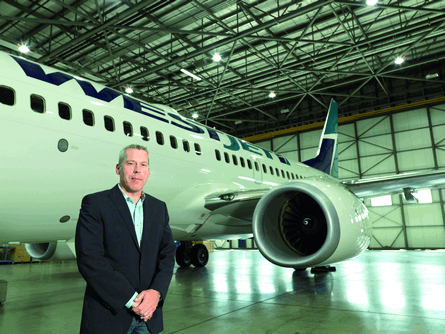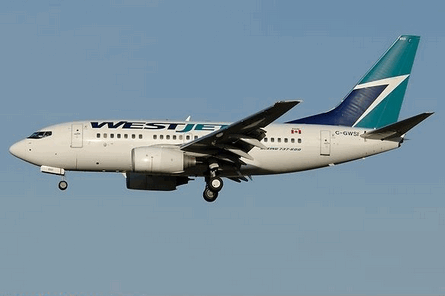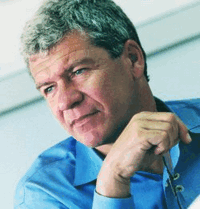On his first anniversary, no one will accuse WestJet chief executive Sean Durfy of being timid. High fuel prices have not prevented him from laying out ambitious growth plans
It's been a tough first year for Sean Durfy. Replacing Clive Beddoe, the iconic co-founder of WestJet, as the Canadian low-cost carrier's chief executive was challenge enough. Climbing the rookie's typical learning curve was also challenge enough. But coping simultaneously with a fuel crisis that grew from a worry into a storm after he took over last September has been Durfy's real baptism of fire. And judging from his response, Durfy is piloting WestJet through it in a fashion that fits the trend-bucking pattern of his mentor and predecessor.
 |
|---|
In the year since Durfy took the controls at Canada's number two airline, fuel prices have doubled. Jet fuel has soared from 27% to 40% of WestJet's operating expenses. Each additional dollar on the price of a barrel of crude oil wipes another $5 million off WestJet's bottom line. You might expect the carrier to model its response on Air Canada's, which has cancelled orders for three Airbus A340s, announced a 7% capacity cut, and plans to lay off 2,000 staff.
Not so. No order cancellations. No layoffs. In fact, says Durfy, "we plan no capacity cuts". This sounds like the defiance of someone who is either oblivious or doesn't care. WestJet's capacity growth, measured in available seat miles, will be 16% this year, compared to 19% last year and a projected 8% next year. By 2010 it will be back up to 10-11%. "We plan an average annual growth of around 10%," says Durfy. "The actual number each year depends on delivery dates."
Analysts have raised concerns about this rate of growth, but Durfy seems intent on charging ahead. "It's the right amount," he insists. By the end of this year, WestJet will operate 77 Boeing 737s, a mix of -600s, -700s and -800s. "We haven't delayed any aircraft orders," he adds. In fact, since Durfy took over, WestJet has ordered four more, raising its five-year goal to operate a fleet of 121 aircraft by 2013.
With all these aircraft, does WestJet plan to move into any vacuums left by others? "Absolutely," says Durfy, citing transborder routes to the USA as one market where he sees great potential. Air Canada is cutting transborder capacity by 13% starting in the fourth quarter. US carriers, which have watched northbound traffic drop as the Canadian dollar rose, are also cutting back. Durfy sees a big opening for WestJet, and hopes to boost its current 9% share of this cross-border traffic to 20% in the next five years.
And Durfy's growth plans are not limited to the US. During this same period, he also aims to boost WestJet's domestic market share from its current 37% to 45-50%. The only thing WestJet does not plan in the next five years is to launch long-haul flights. Aside from this one note of reserve, Durfy sounds like a chip off Clive Beddoe's block.
 |
|---|
"Most opportunities come when an industry is in chaos. We'll be the last dog standing"Sean Durfy |
Others, especially on the beleaguered US side of the border, might view such talk as midway between defiant and reckless. From the perspective of WestJet's Calgary base, however, it is easier to understand. Durfy himself concedes that the rising Canadian dollar helped hedge against the impact of rising US-denominated fuel prices. Now that Canadian and US exchange rates have stabilised around parity, this advantage is gone. But Canada's economy remains stronger. The International Monetary Fund expects the Canadian economy to expand this year at almost three times the US rate.
Durfy elaborates: "Canada has become a petrol-currency economy. We're shifting from a manufacturing base to resource commodities. As fuel prices have gone up, western Canada has actually received a boost." Thanks to this boost, Calgary feels akin to a boom town. Development of Alberta's vast oil sands has been like a gold rush, driving up employment, real estate values and population. Locals complain, tongue in cheek, that "there are more Newfies now in Alberta than in Newfoundland".
Durfy - who hails from Newfoundland - is one of them, but he has been in Calgary long enough to see the world from a Calgary perspective, and from this vantage one can understand why an airline executive could feel bullish. Durfy might admit his growth plans are aggressive, but he denies being reckless. By the time he came to WestJet from a Calgary utility company, he believes he had matured. "We've proved to the board of directors and shareholders that this management team knows what they're doing," he says.
Growing while others shrink may be the over-arching strategy, but Durfy has not ignored the impact of higher fuel costs. He ticks off a long list of steps WestJet has taken to trim fuel consumption. These include: slowing aircraft speeds down from Mach .878 to .765 new engine cleaning technology carrying less potable water and being among the first to employ winglets on new generation 737s. The cumulative effect of these measures, he estimates, is a fuel saving of 6%.
In May WestJet also introduced its first fuel surcharge, matching Air Canada on short sectors but staying below its rival's surcharge on mid- and longer-haul flights. Analysts estimate that WestJet's surcharge raises fares by an average of 10-15%. Durfy is apologetic about the surcharge. "We had no choice," he says, but he thinks it hurt WestJet's image. "We're about market stimulation," but tacking this surcharge on top of taxes "is causing the cost of air travel in Canada to creep up".
Since the surcharge, WestJet has also detected a shift in booking patterns. Travellers used to book about 30 days ahead now it is longer. Durfy suspects they fear more surcharges and want to lock in current ticket prices before they go up. He remains unsure about the effect on demand of surcharges. Load factors in the past several months have stopped growing, but during this period WestJet also added capacity. Are the lower loads due to extra seats or the start of a demand slowdown? "It's a hard dynamic to figure," Durfy admits. "We're still on the fence as to whether demand is softening." All he can say for sure is that, with passengers booking further ahead, "our load factor in September is way up".
Some low-cost carriers see the fuel crisis as a blessing in disguise, especially those, such as WestJet, which blend low-cost traits with those of full-service carriers. Less dependent than traditional low-cost carriers on discretionary leisure travel, these airlines see a chance to make inroads into the business travel markets of their network rivals.
 |
|---|
© Peter Unmuth/AirTeamImages.com |
With the rising cost of travel, Durfy is convinced that WestJet has an advantage over Air Canada in attracting the cost-conscious road warrior. "Business travellers who can't fly business class any more because of the astronomical fares are trying WestJet," he says. At the moment, 45% of WestJet's passengers are now business travellers, and Durfy predicts this will reach 50% this year. He cites a long list of features WestJet provides to attract these customers, from allowing passengers to issue boarding passes via their mobile phones to treating them "humanely".
"We spend millions on guest segmentation and research," he explains. "What we do is predicated on what our guests want. In this sense, we move with the market."
WestJet learned long ago the importance of being a hub and spoke carrier rather than operating only point-to-point. Canada's geography, Durfy explains, compels this. With 80% of all Canadians living within 100mi (161km) of the US border, 40% of all WestJet passengers connect through some airport to fly on to another. Thus, from the outset WestJet has provided baggage check-through and seat assignments on connecting flights.
Early next year, WestJet will start to implement another change driven by business travellers: multi-fare pricing. The simple days of one-price-fits-all will vanish. Instead, fares will be based on how far ahead they are booked, date and time of travel, and so forth. "Value-added services" may also become part of this. Those who pay a higher fare, for instance, might receive a window or exit row seat, seat assignment at the time of booking, more in-flight amenities, and greater flexibility to change flights without penalty. "But we can't make it too complicated," Durfy warns, predicting that WestJet will only offer a three-tier package.
One type of pricing that WestJet will not expand is the passbook now popular at Air Canada, where a passenger may buy a book of, say, 10 tickets with a quantity discount for use on select routes. Competition forced WestJet to match this offer on the Toronto-Ottawa-Montreal triangle, but Durfy does not plan to extend it elsewhere. "I think they're diversionary," he says. Savvy passengers only use passbook tickets, in his view, when the short-term fare is higher. "They always compare the current fare with the coupon price before they decide which one to use. I have yet to see the math that tells me passbooks will work."
He sees better and more profitable ways to attract business traffic. One is for WestJet to launch its own loyalty plan, which it will do next year when its current contract expires with Air Miles. Air Miles is a multi-party programme in which WestJet has been one of many retail sponsors and reward partners. Durfy says Air Miles is fine for what it is, but it does not offer WestJet the same flexibility as a programme of its own. "There's some neat stuff you can do if you have control of your own loyalty programme," he says. For instance, he wants a plan that can stimulate travel during slow periods by offering extra points. "We've already done lots of research," he says, adding WestJet's programme will take effect in the first or second quarter of 2009.
A new computer reservation system may be the biggest challenge WestJet faces next year. Launching a loyalty plan is not as dependent as some aspects of multi-fare pricing on a new system, but Durfy sees a next-generation computer system as the key to other strategic goals - particularly interlining with other airlines.
Last year WestJet wrote off its abortive effort to develop and implement a tailor-made AiRes system, and it is committed through this year to Navitaire's upgraded Open Skies. One programme under consideration is the New Skies product that Navitaire will also offer. Durfy predicts WestJet will pick a new system "very soon", and he cautiously hopes to switch over by no later than the third quarter of next year. Whatever WestJet chooses, he insists, it will not be a special-built programme. After being burned by the AiRes experience, WestJet will stick with off-the-shelf models. Navitaire's upgraded Open Skies system already allows WestJet to interface somewhat with the computer systems of other airlines. "It works for inbound codeshares, but not for outbound," says Durfy. A new system may address this problem, but it will not solve other interline issues that annoy Durfy.
WestJet has talked with a number of foreign carriers, especially oneworld members, that would prefer traffic feed to and from a Canadian airline other than Star Alliance member Air Canada. WestJet would seem the logical option, but the only overseas carrier so far to interline with WestJet is Taiwan's China Airlines. "The legacy guys seem rigid," Durfy complains. "They seem to have certain models with hard and fast rules about alliances with other airlines." Frequent flyer reciprocity and revenue splitting are the biggest hang-ups, he says. "They seem to be most concerned about who's getting the upper hand."
By contrast, Durfy is enthusiastic about WestJet's memorandum of understanding to form a codeshare alliance next year with Southwest Airlines. The transborder market is worth $4 billion, Durfy says, and the link to Southwest is a key element in WestJet's plan to boost its share of this market. WestJet will operate all transborder flights under this agreement, but will carry Southwest passengers north-south and feed its own passengers into Southwest's extensive US system. In addition to traffic feed and joint marketing, both airlines foresee cost savings through joint purchases and services. "We're spending a lot of time and effort making sure that the Southwest relationship, operational structure, and so forth is working and ready to go by the end of 2009," Durfy says.
Aggressive growth when others are pulling back, multi-fare pricing, a standalone loyalty plan, a computer reservation system designed for full interlining, and an alliance-in-progress with the largest US domestic carrier - these are not the attributes of a timid or traditional low-cost carrier. At a time when the industry is in crisis mode, these represent bold moves. They also prompt the question of what a rookie chief executive will be plotting by the time of his second anniversary.
BIG SHOES TO FILL
"I didn't step into Clive Beddoe's shoes and I never will," says WestJet chief executive Sean Durfy. Beddoe, as co-founder and leader of WestJet for its first 11 years, left his indelible mark on the airline, and Durfy knows how hard it is to follow that lead.
"Clive has forgotten more than I will ever know," Durfy says with a good dose of humility. "I can't be him, and I don't want to be him. I'm only Sean Durfy, but I'll be the best Sean Durfy I know how to be."
 |
|---|
Functionally, Durfy says his role did not change that much when he became chief executive in September 2007. He had already been president for a year, and in that role, "I was already in charge of strategy and day-to-day operations".
"The big difference was cultural," he recalls. "Around the same time as I became chief executive, we had a number of other founders also leaving." When Beddoe stepped down, "people realised that Clive had truly retired to the chairman role and this was the guy - me - running the ship. That was a big dynamic shift."
Durfy was not, in fact, Beddoe's first attempt at finding a successor. In 1999 Beddoe appointed an outsider as president and chief executive. But the new man, Stephen Smith, who had been an Air Canada manager who came from a carrier called Air Ontario, tried to impose a top-down management style that did not fit. That failed experiment taught Beddoe that his successor needed to be part of WestJet's executive team before taking over the controls. This time it seems to have been more successful.
ELECTRIC RISE
Born, raised, and educated in Atlantic Canada, Sean Durfy graduated from Dalhousie University in Halifax and moved west to make his mark with a degree in marketing and finance. In 1999 he formed Enmax Energy Corporation in Calgary and guided the company through the deregulation of Alberta's electricity industry. Under Durfy's leadership as president and chief operating officer, Enmax grew into a $1.3 billion utility business before he left in 2004.
At the invitation of WestJet co-founder Clive Beddoe, who was looking for a successor, Durfy joined the airline that year as executive vice-president sales, marketing and airports. After two years on WestJet's executive team, Durfy became the airline's president in September 2006. Still pleased with what he saw, Beddoe turned the chief executive post over to Durfy a year later. Since September 2007, 42 year-old Durfy has been both WestJet's president and chief executive.
Source: Airline Business



















